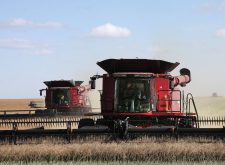CHICAGO (Reuters) — John Goihl, a hog nutritionist in Shakopee, Minnesota, knows a farmer in his state who lost 7,500 piglets just after they were born. In Sampson County, North Carolina, 12,000 of Henry Moore’s piglets died in three weeks. Some 30,000 piglets perished at John Prestage’s Oklahoma operation in the fall of 2013.
The killer stalking U.S. hog farms is known as PED, a malady that in less than a year has wiped out more than 10 percent of the American pig population and helped send retail pork prices to record highs. The highly contagious porcine epidemic diarrhea virus is puzzling scientists searching for its origins and its cure and leaving farmers devastated in ways that go beyond financial losses.
Read Also

B.C. ostriches culled, CFIA confirms
Ostriches on an embattled Edgewood, B.C. farm have been culled after a prolonged legal battle, the Canadian Food Inspection Agency has confirmed.
“It’s a real morale killer in a barn. People have to shovel pigs out instead of nursing them along,” Goihl said.
Since June 2013 as many as seven million pigs have died in the United States due to the virus, said Steve Meyer, president of Iowa-based Paragon Economics and consultant to the National Pork Board said. United States Department of Agriculture data showed the nation’s hog herd at about 63 million as of March 1, 2014.
PED was first diagnosed in Ohio last May and has spread within a year to 30 states with no reliable cure in sight. The virus has also been found in four Canadian provinces.
U.S. packing plants may produce almost two percent less pork in 2014, according to Ken Mathews, USDA agricultural economist.
Last week, the USDA responded to calls for more reliable data and classified PED as a reportable disease, a step that requires the pork industry to track its spread.
“It’s a positive step that I wish they had taken last summer when it became obvious this was spreading rapidly,” said Meyer.
Most farmers and researchers believe PED is transmitted from pig to pig by contact with pig manure.
“Something like a tablespoon of (PED) infected manure is roughly enough to infect the entire U.S. hog herd,” said Rodney “Butch” Baker, swine biosecurity specialist at Iowa State University.
The National Pork Board has spent about $1.7 million researching the virus, which is nearly always fatal in pigs younger than 21 days. With pork prices at an all-time high of $3.83 a pound, the loss of baby pigs cuts into profits for hog farmers.
“If you have four weeks of mortality in a (PED) break, that’s pretty devastating to the financial wellbeing of that operation,” said Greg Boerboom, a Minnesota hog farmer.
“I think most producers are scared,” Boerboom said. “They stay up at night.”
PED does not pose a risk to human health and is not a food safety issue, the USDA says.
Months of forensic research so far have turned up no clear evidence of how the disease entered the United States.
The virus is nearly identical to one that infected pigs in China’s Anhui province, according to a report published in the American Society of Microbiology journal mBio. Researchers also are exploring whether the widespread use of pig-blood byproducts in hog feed might have introduced the disease.
There have been outbreaks in recent years in Europe, Japan, Mexico and parts of South America, though in milder forms than seen in the U.S. and China.
PED thrives in cold, damp environments, and after slowing last summer its spread accelerated during the past winter. In mid-December, there were over 1,500 cases but by mid-April, that had more than tripled to 5,790, according to USDA data.
Altogether, of nearly 15,000 samples tested for PED about 32 percent have been positive.
The virus “acts like a lawn mower” on the villi in a pig’s intestines, which are the tiny projections that aid digestion, said Tony Forshey, chief of animal health at the Ohio Department of Agriculture. With their villi gone, the piglets cannot absorb nutrients from food or water, contract diarrhea and die from dehydration.
So far, no vaccine has been able to completely protect pigs from the disease. An Iowa company, Harrisvaccines Inc., has made some progress, while pharmaceutical giants Merck Animal Health and Zoetis Inc have joined with universities to begin vaccine development.
“There is no silver bullet for (PED),” said Justin Ellis, marketing manager at Alltech, which developed a feed additive designed to reduce risk of the disease.=
The disease is spreading even as farmers and truckers impose stricter cleanliness measures across the so-called Hog Belt, which stretches across most of the U.S. Midwest and Plains States and extends south to North Carolina, the nation’s No. 2 hog producer. Iowa ranks first.
“It’s a complete lifestyle change,” said Iowa State’s Baker. “In the past the truckers haven’t thought of biosecurity much.”
Some hog farmers prohibit outside visitors. Others require workers to change clothes when entering and leaving barns. Truck drivers wipe down the step into their cabs, disinfect their steering wheels and change boots or wear disposable booties before entering farm yards.
The industry wants truck washes to use fresh water instead of recycled, since PED can live in room temperature water for up to 13 days, a University of Minnesota study said.
“The only truck I regularly allow on site is the feed truck and last November I told the driver not to get out of the truck,” said Bill Tentinger, an Iowa farmer who so far has kept PED at bay.
The extra washing, drying and disinfecting can consume at least two hours and cost up to $500 per load, industry sources said.
Bright yellow signs marked “PED” are popping up outside North Carolina farms warning the virus is present. One-third of North Carolina’s 3,000 hog farms have been struck by PED since the first diagnosed case there in June 2013, the state says.
So many piglets have died that Tom Butler, a farmer who fattens hogs for market in southeastern Harnett County, is having difficulty finding animals. His herd is down 25 percent to 6,000 pigs, costing him more than $100,000.
“We were spiraling downhill for a while but I think we’ve leveled off,” Butler said. “The industry is learning to cope.”














